Easy, Simple, Small Charcuterie Board Recipe
Alright friends, let’s talk about elevating date nights with my easy small charcuterie board recipe. Perfectly curated for two, that savor a symphony of flavors in every bite.
Welcome back, friends! One of the things I love to do for dinner is a simple charcuterie.
Hey! It has all the food groups so why not. I guarantee at times keeping things simple is the perfect solution to getting in, and out, of the kitchen quickly.
Plus, indulging in a delightful charcuterie experience doesn’t have to be reserved for large gatherings or special occasions.
Whether it’s a cozy date night or a leisurely afternoon picnic, crafting an easy and simple small charcuterie board allows you to savor a delectable assortment of flavors without all the fuss. That right there sounds pretty good to me.

In today’s blog post, I’ll guide you through the art of curating the perfect charcuterie board for two, offering a medley of savory bites, cheeses, fruits, and accompaniments that celebrate both your palate and your special someone!
So come on! Get ready to embark on a journey of taste and togetherness with our curated tips and tantalizing pairings!
What does the word charcuterie mean?
What exactly does charcuterie mean?
Several years back the simple charcuterie board became a big trend in entertainment. Meats and cheeses anyone?
In our home, we grew up simply referring to it as meat and a small cheese board. Fast forward to everyone using the fancy word charcuterie, which means cured meats.
Just the name alone sounds fancy, doesn’t it?
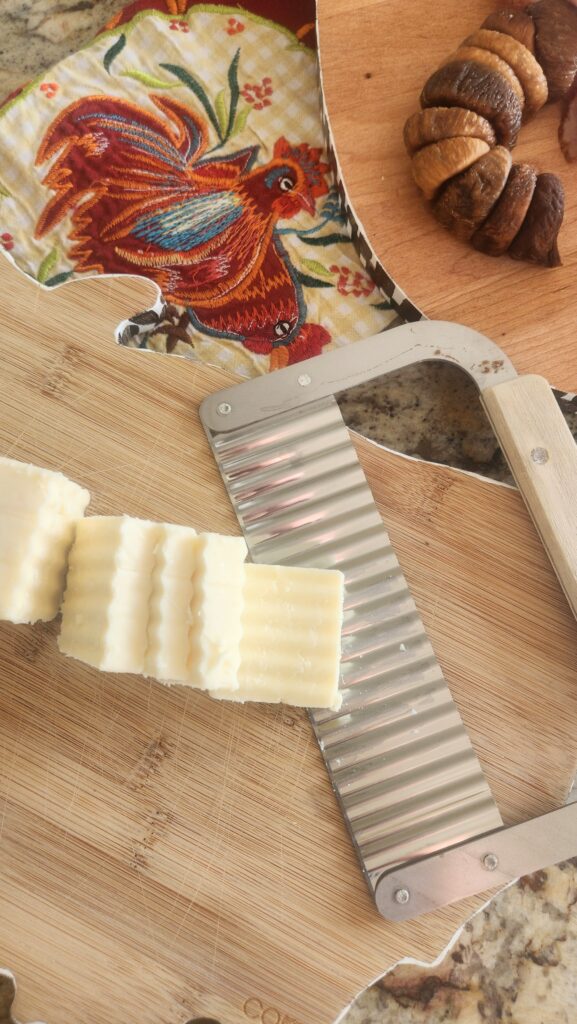
A good charcuterie board requires different textures
The culinary practice of preparing and assembling a good charcuterie board requires different textures, cured meats, and other favorite cheeses. It’s a term that encompasses both the art of creating a visually appealing platter and presentation.
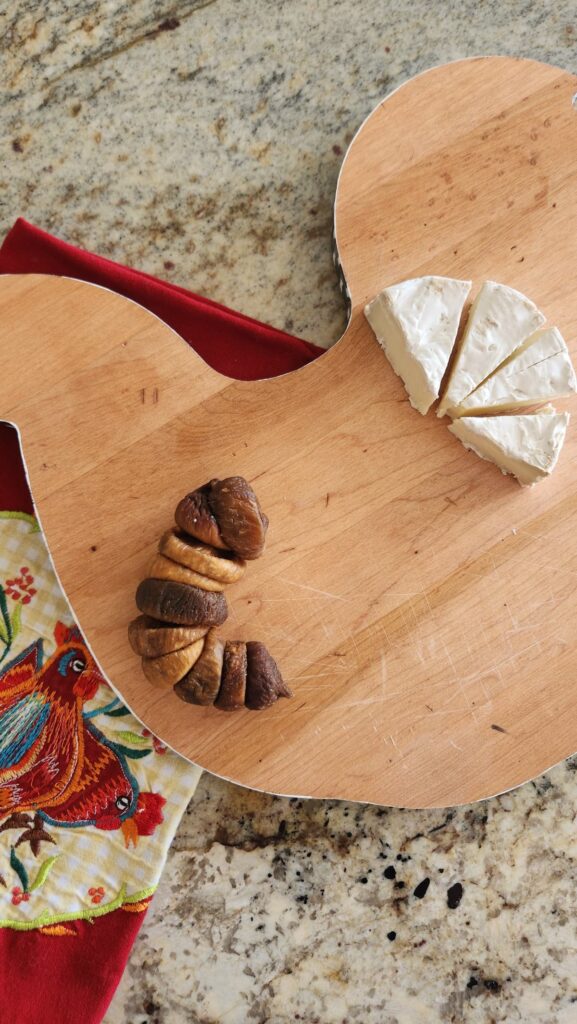
What should go on a small charcuterie board?
Here is a list of what items you can consider including with your small charcuterie board. A small charcuterie board is all about balance and variety.
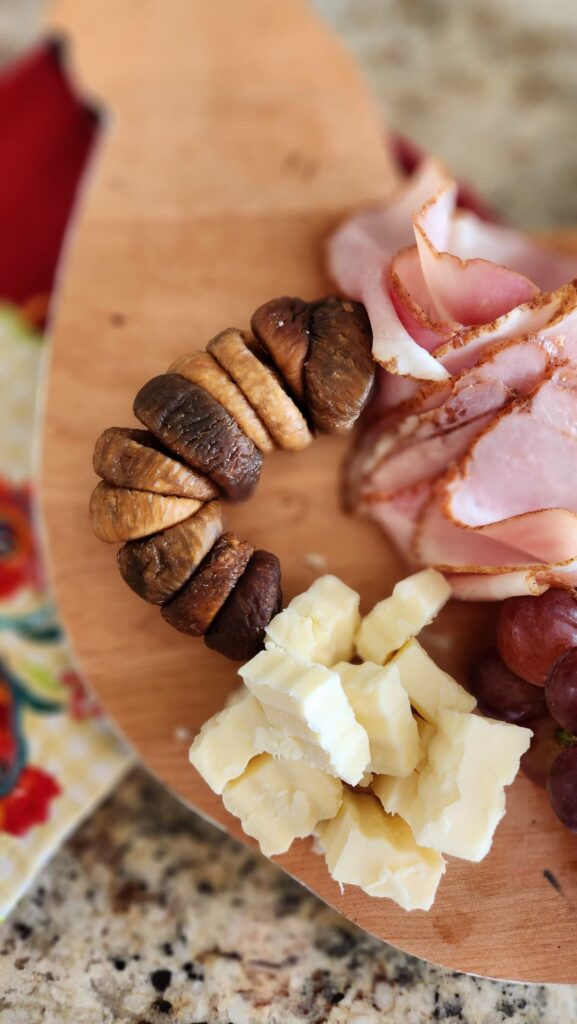
Feel free to add your favorites
- Cured Meats: Select a couple of high-quality cured meats such as prosciutto, salami, or chorizo. These cold cuts provide a rich and savory element to your board.
- Cheeses: Choose a mix of soft and hard kinds of cheeses. Options like brie cheese, cheddar, goat cheese, and gouda offer a diverse range of flavors and textures.
- Crackers and Bread: Provide an assortment of crackers, breadsticks, and sliced baguettes to complement the meats and cheeses.
- Fresh Fruits: Incorporate seasonal fruits like grapes, figs, apple slices, or berries. They add a refreshing sweetness that balances the saltiness of the meats and cheeses.
- Nuts: Include a variety of nuts such as almonds, walnuts, or cashews. They add a satisfying crunch and pair well with the other components. Personally, one of my favorite things is Brazil nuts. I love adding them since they are full of selenium.
- Olives and Pickles: Offer a selection of olives, gherkins, or pickled vegetables to provide a tangy and briny element.
- Spreads: Add some spreads like honey, fruit preserves, or whole-grain mustard. These can be drizzled over cheeses or used as dipping accompaniments.
- Dried Fruits: Mix in dried apricots, cranberries, or raisins for additional texture and a touch of sweetness.
- Fresh Herbs: Garnish the board with fresh herbs like rosemary or thyme to add a fragrant and visually appealing touch.
- Extras: If you have space, adding other favorite options such as dark chocolate, small clusters of grapes still on the vine, or even a small bowl of hummus for added depth is always a great addition.
Remember, the key is to create a visually appealing arrangement with a variety of flavors, textures, and colors. Tailor your selections to your preferences and the season for a delightful and well-rounded experience.
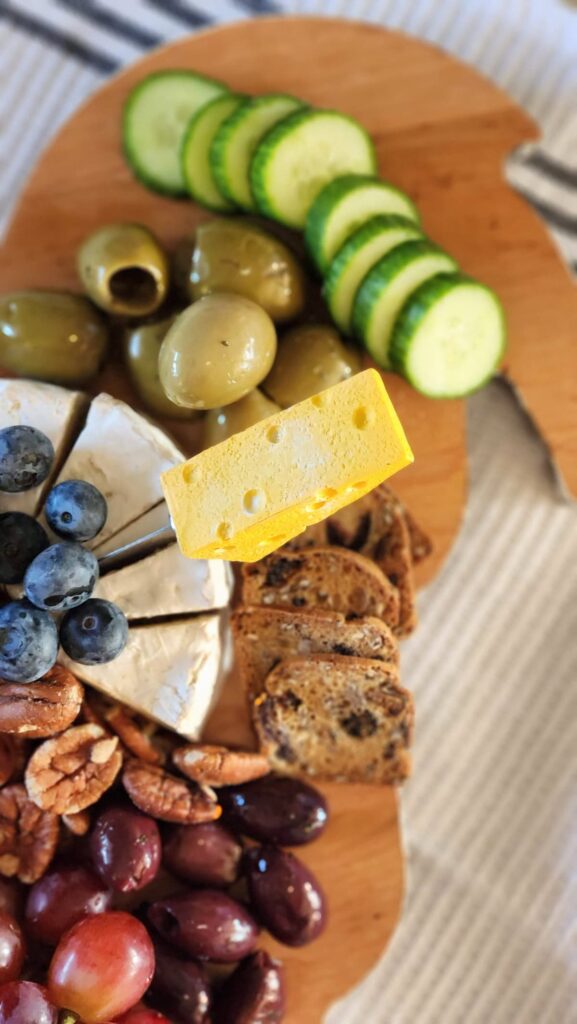
How many cheeses do I need for a small charcuterie board?
For a smaller charcuterie platter, adding two to three types of cheeses is a good idea. On a smaller board, the combination of a variety of cheeses will round out your selection and complement the other items on your board.
A good idea is to aim for soft cheese, such as brie, a hard cheese like cheddar, and a stronger flavored cheese such as blue cheese or goat cheese.
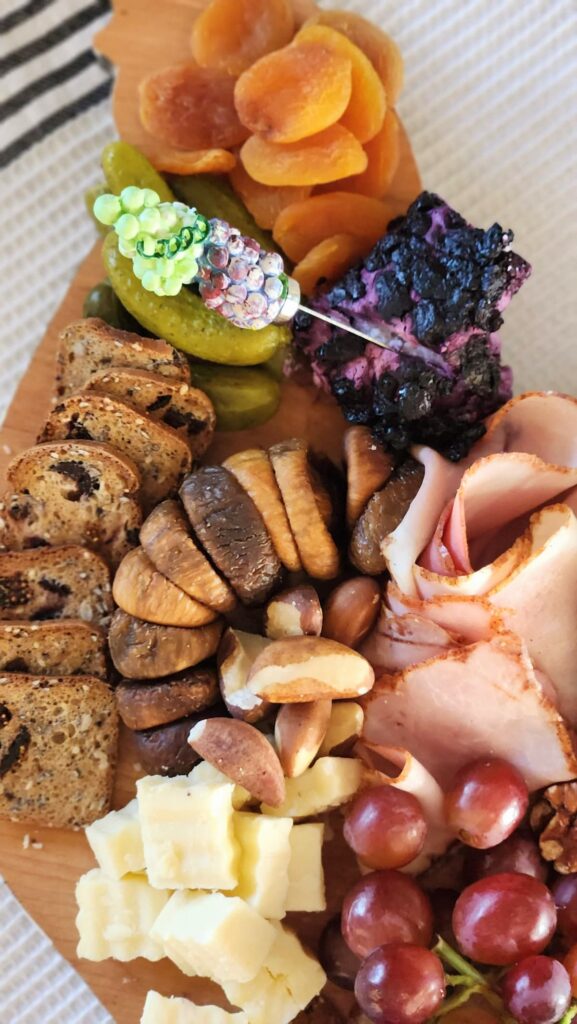
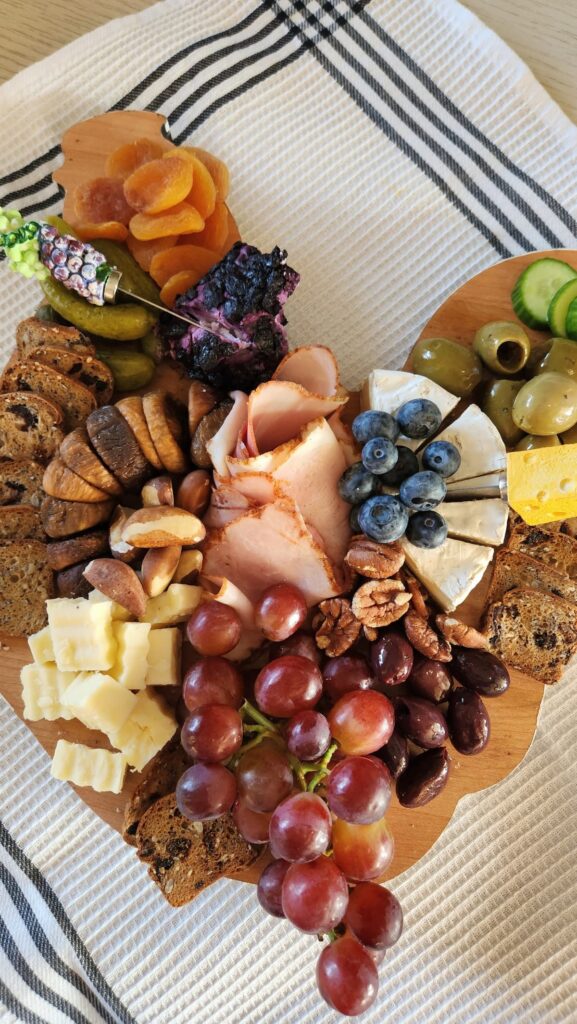
What is a mini charcuterie board used for?
When it comes to uses for a mini charcuterie board the options are as big as you can imagine. There is nothing ‘mini’ about delicious flavor.
I’ve been known to ‘smuggle’ a few airtight containers filled with fresh fruit, spreadable cheese, and little charcuterie meats onto golf courses. Nothing says golf better than individual platters served with a plastic champagne glass filled with a mimosa! If you don’t tell, I won’t either and you’re invited to golf with us anytime! I digress. ha
The point is a mini charcuterie or what I call small boards is the perfect appetizer no matter where you are.
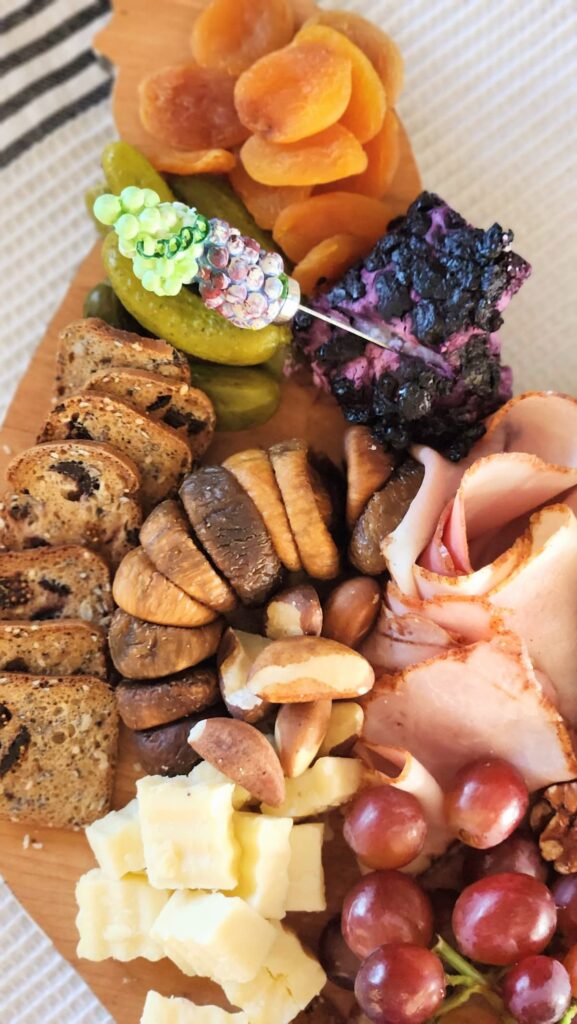
How to make a small charcuterie board?
What you’ll need:
- Sliced Ham
- Red Grapes
- Small Cucumber
- Dried Apricots
- Dried Figs
- Blueberries
- Brie Cheese
- Sharp Cheddar Cheese
- Blueberry Goat Cheese
- Baby Pickles
- Green Olives
- Black Kalamti Olives
- Pecans
- Brazil Nuts
- Crackers of your Choice
Step-by-step instructions
Here’s a step-by-step guide to help you put together a delicious charcuterie board:
- Step 1: Gather Your Supplies Collect all the necessary items before you start assembling your charcuterie board. Most items can easily be found at your local grocery store. You’ll need a wooden board, slate board, or a large board (for a larger group) as the base. Also, gather your selection of meats, cheeses, fruits, crackers, and condiments.
- Step 2: Select Meats and Cheeses Choose a variety of meats and cheeses. Opt for a mix of flavors, textures, and types. Common charcuterie meats include prosciutto, salami, and chorizo. For cheeses, consider options like brie, cheddar, gouda, and blue cheese.
- Step 3: Prepare the Meats and Cheeses Arrange the meats by folding or rolling them into different shapes or creating a salami rose. Cut the cheeses into bite-sized pieces, triangles, or cubes. Keep in mind the aesthetics of the arrangement.
- Step 4: Choose Fruits and Nuts Select a few fresh fruits that complement the flavors of the meats and cheeses. Grapes, berries, figs, and apple slices are popular choices. Add a variety of nuts like almonds, walnuts, or pistachios for added crunch.
- Step 5: Add Crackers and Bread Incorporate an assortment of crackers, breadsticks, and sliced baguettes. These items serve as a vehicle for your meats, cheeses, and spreads.
- Step 6: Include Spreads and Condiments Enhance the flavors with various spreads and condiments. Honey, fig jam, mustard, chutneys, and olive tapenade are excellent choices. Place smaller items in small bowls or directly on the board for easy dipping and spreading. These cheese knives not only look great but help tremendously.
- Step 7: Arrange Everything Start by placing larger items like cheeses and bowls of spreads onto the board. Distribute them evenly to create balance. Then, arrange the meats in rolls or folds, creating height and texture. Fill in any empty spaces with fruits, nuts, and crackers.
- Step 8: Consider Aesthetics Think about the visual appeal of your charcuterie board. Mix colors, shapes, and sizes to create an eye-catching arrangement. Play with textures to make the board look more inviting.
- Step 9: Add Garnishes (Optional) If you’d like, add some fresh herbs like rosemary or thyme for a touch of greenery and fragrance. Edible flowers can also add a pop of color.
- Step 10: Serve and Enjoy Once your charcuterie board is assembled, place it in a prominent location at your gathering. Serve with wine, sparkling water, or your beverage of choice. Invite your guests to explore the different flavors and combinations.
Remember, the best part about charcuterie boards is that they are versatile, so feel free to get creative and personalize your board in a fun way. Enjoy the process of arranging and indulging in this delectable spread!
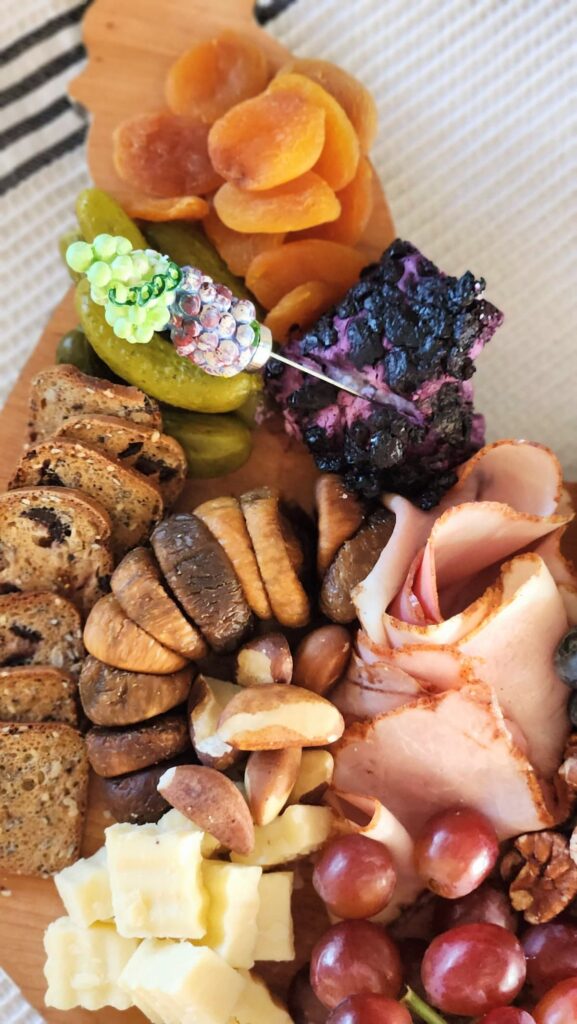
Small Charcuterie Board Recipe
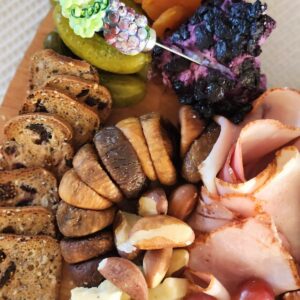
Small Charcuterie Board Recipe
Ingredients
- 7 Thinly sliced Off the bone Ham
- 10 Dried Apricots
- Small Bunch of Red Grapes
- 9 Dried Figs
- 1 Small Cucumber (sliced thin)
- 10 Blueberries
- 6 slices Slices of Sharp Cheese
- 2 oz Blueberry Goat Cheese
- 2 oz Brie Cheese
- 7 Baby Dill Pickles
- 8 Green Olives
- 9 Black Olives
- Pecans
- Brazil Nuts
- Crackers (your choice)
Instructions
- Step 1: Gather Your Supplies Collect all the necessary items before you start assembling your charcuterie board. Most items can easily be found at your local grocery store. You'll need a wooden board, slate board, or a large board (for a larger group) as the base. Also, gather your selection of meats, cheeses, fruits, crackers, and condiments.
- Step 2: Select Meats and Cheeses Choose a variety of meats and cheeses. Opt for a mix of flavors, textures, and types. Common charcuterie meats include prosciutto, salami, and chorizo. For cheeses, consider options like brie, cheddar, gouda, and blue cheese.
- Step 3: Prepare the Meats and Cheeses Arrange the meats by folding or rolling them into different shapes or creating a salami rose. Cut the cheeses into bite-sized pieces, triangles, or cubes. Keep in mind the aesthetics of the arrangement.
- Step 4: Choose Fruits and Nuts Select a few fresh fruits that complement the flavors of the meats and cheeses. Grapes, berries, figs, and apple slices are popular choices. Add a variety of nuts like almonds, walnuts, or pistachios for added crunch.
- Step 5: Add Crackers and Bread Incorporate an assortment of crackers, breadsticks, and sliced baguettes. These items serve as a vehicle for your meats, cheeses, and spreads.
- Step 7: Arrange Everything Start by placing larger items like cheeses and bowls of spreads onto the board. Distribute them evenly to create balance. Then, arrange the meats in rolls or folds, creating height and texture. Fill in any empty spaces with fruits, nuts, and crackers.
- Step 8: Consider Aesthetics Think about the visual appeal of your charcuterie board. Mix colors, shapes, and sizes to create an eye-catching arrangement. Play with textures to make the board look more inviting
- .Step 9: Add Garnishes (Optional) If you'd like, add some fresh herbs like rosemary or thyme for a touch of greenery and fragrance. Edible flowers can also add a pop of color.
- Step 10: Serve and Enjoy Once your charcuterie board is assembled, place it in a prominent location at your gathering. Serve with wine, sparkling water, or your beverage of choice. Invite your guests to explore the different flavors and combinations.
Shop my favorites

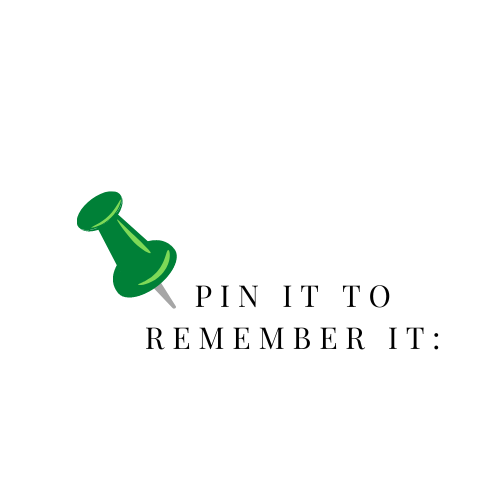
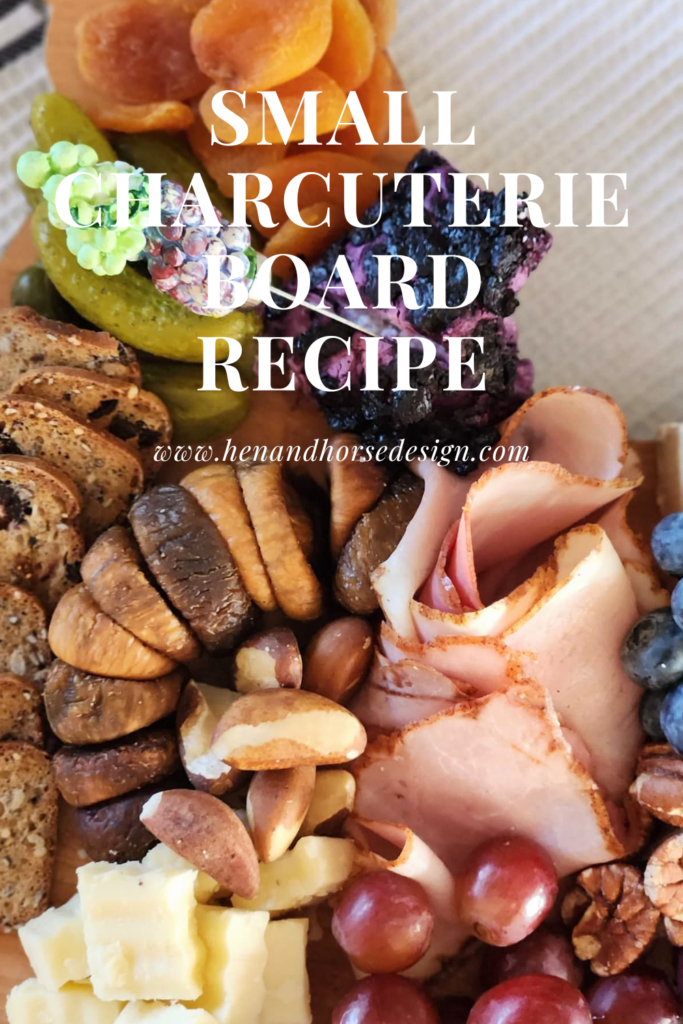
FAQs about Easy and Simple, Small Charcuterie Board Recipe
1. What is a charcuterie board? A charcuterie board is a visually appealing arrangement of cured meats, cheeses, fruits, nuts, and other complementary items. It’s designed to create a delightful sensory experience that balances flavors, textures, and colors.
2. How do I choose the right meats for my charcuterie board? Opt for a selection of cured meats such as prosciutto, salami, or chorizo. Choose meats with varying levels of spiciness and richness to cater to different taste preferences.
3. How many cheeses should I include? For a small charcuterie board serving two, 2 to 3 types of cheeses are recommended. Mix different varieties to offer a diverse range of flavors and textures.
Can you customize the charcuterie board based on dietary preferences?
4. Can I customize the charcuterie board based on dietary preferences? Absolutely! You can adapt the board to accommodate dietary needs. Include vegan cheeses, plant-based proteins, gluten-free crackers, and a variety of fruits and nuts.
5. What fruits work well on a charcuterie board? Fresh fruits like grapes, figs, apple slices, and berries provide a sweet and refreshing contrast to the savory elements. Choose fruits that are in season for the best flavors.
6. Are there any vegetarian options for a charcuterie board? Definitely! Load up on an assortment of cheeses, nuts, olives, pickled vegetables, fresh and dried fruits, as well as a variety of spreads to create a satisfying vegetarian charcuterie board.
7. How can I make the charcuterie board visually appealing? Arrange items in small clusters or rows, alternating colors and textures. Use small bowls for spreads, and add sprigs of fresh herbs for garnish. Don’t be afraid to play with different shapes and heights to create visual interest.
Can I prepare the Charcuterie board in advance?
8. Can I prepare the charcuterie board in advance? Absolutely. Many components can be prepped in advance. Slice meats and cheeses, wash and dry fruits, and portion out nuts. Assemble the board shortly before serving to keep everything fresh.
9. What drinks pair well with a charcuterie board for two? Wine, both red and white, is a classic choice. Sparkling wine, rosé, or even craft beer can also complement the flavors. Non-alcoholic options like sparkling water or a fruit-infused mocktail work well too.
10. Can I adjust the portion sizes on the charcuterie board recipe? Certainly! The beauty of a charcuterie board lies in its flexibility. Feel free to adjust the quantities based on your appetite and preferences.
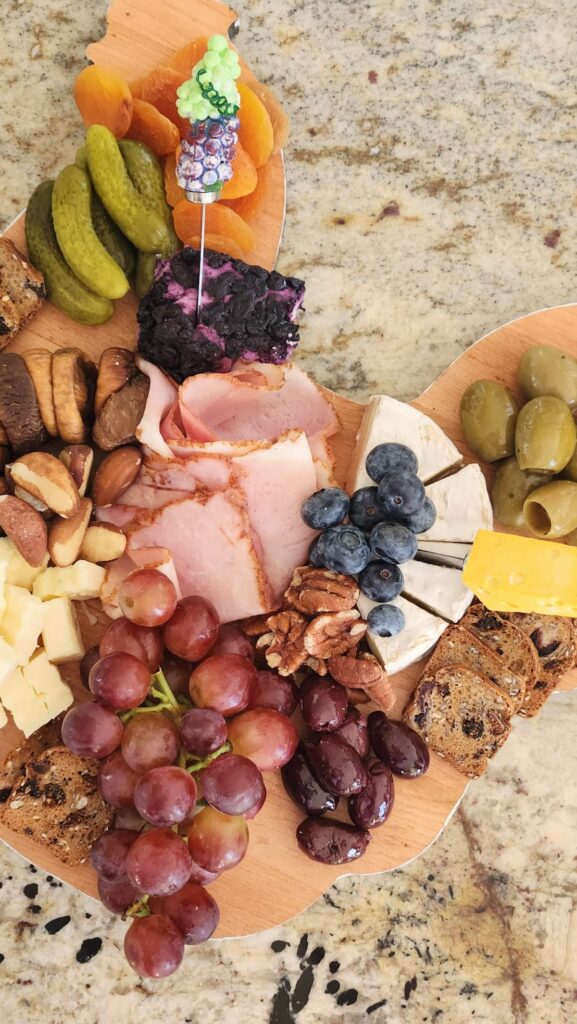
Creating a small charcuterie board for two is a delightful way to share an intimate meal with a loved one. With the right combination of flavors and thoughtful arrangement, you’re in for a memorable culinary experience.


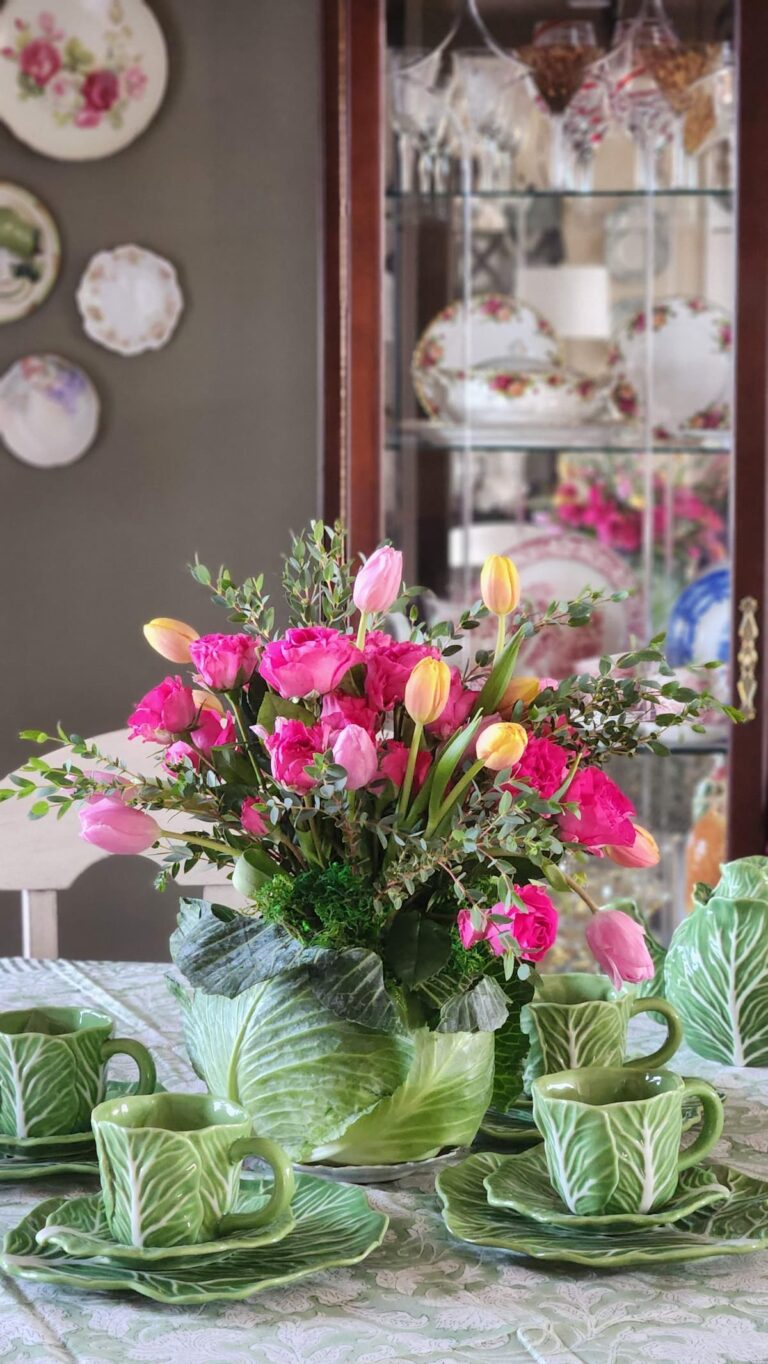
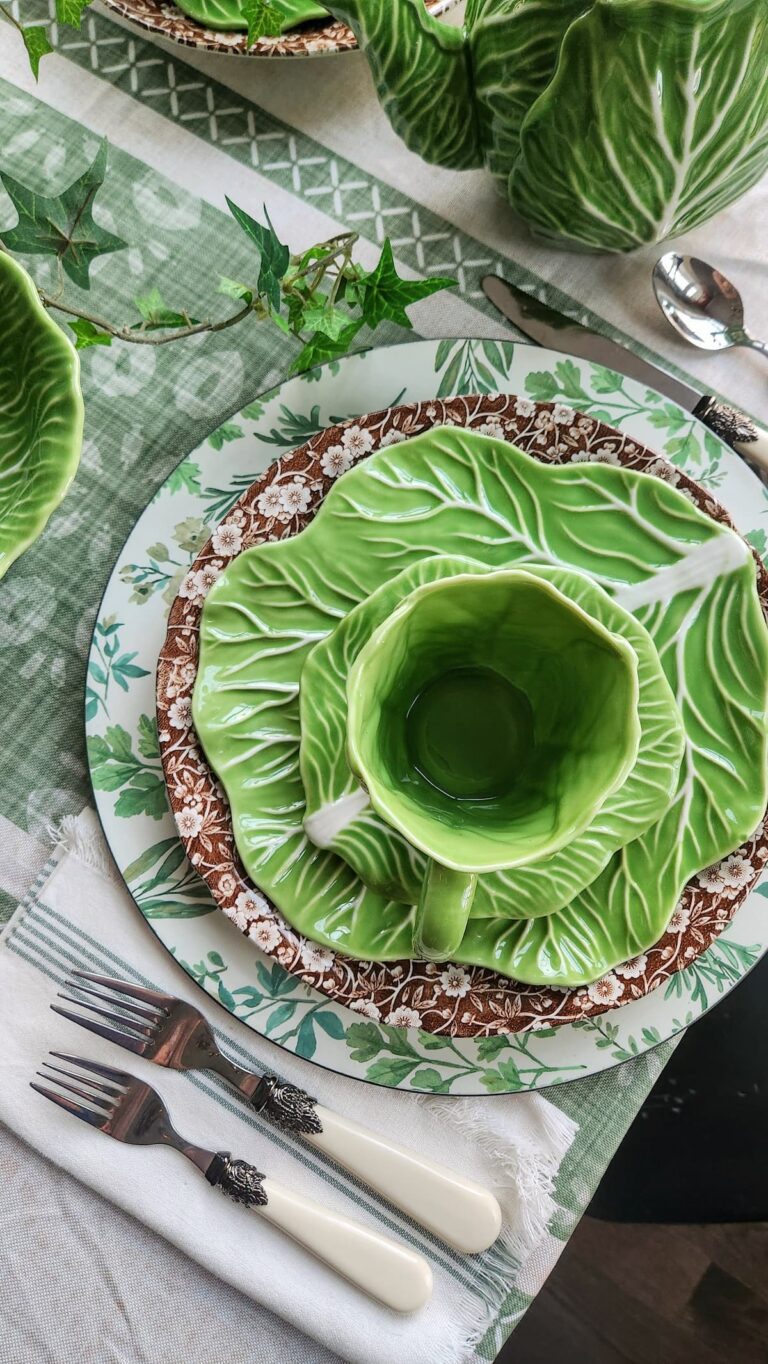
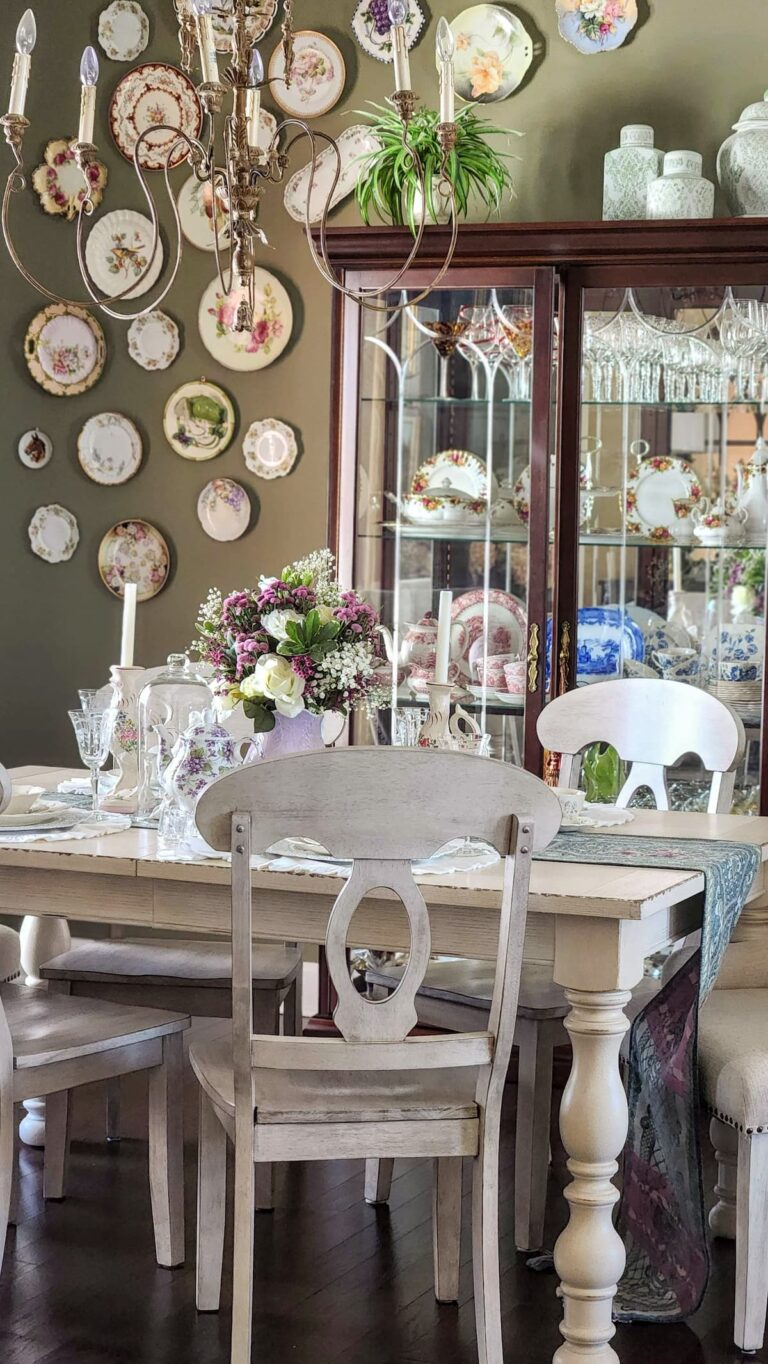
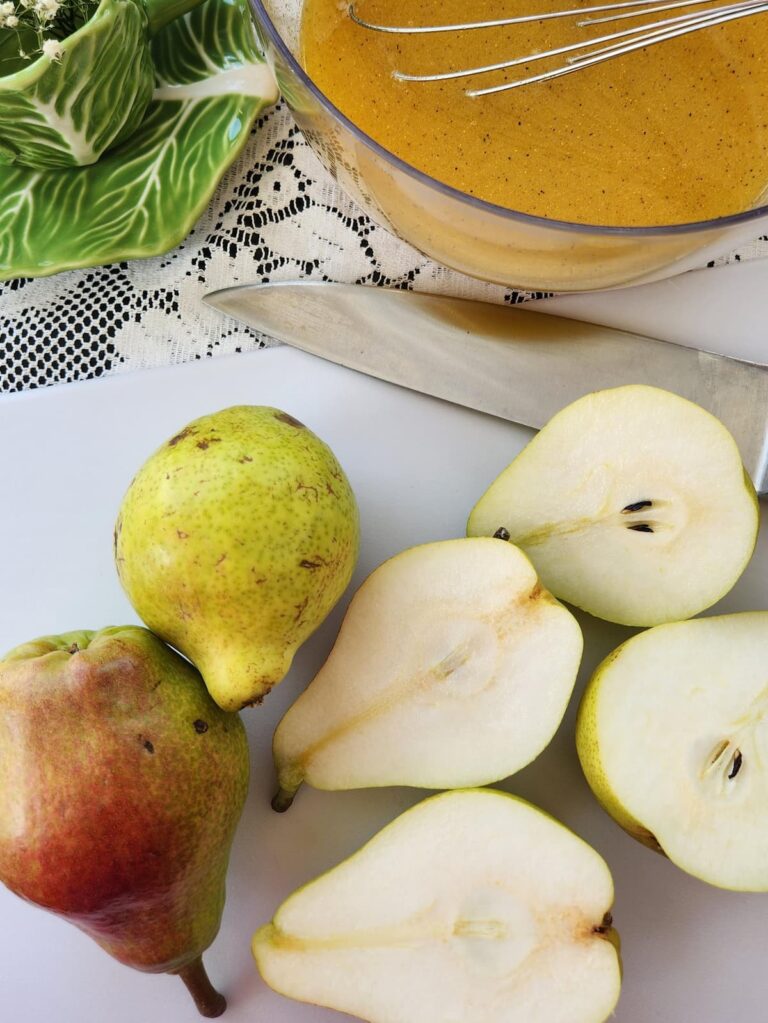
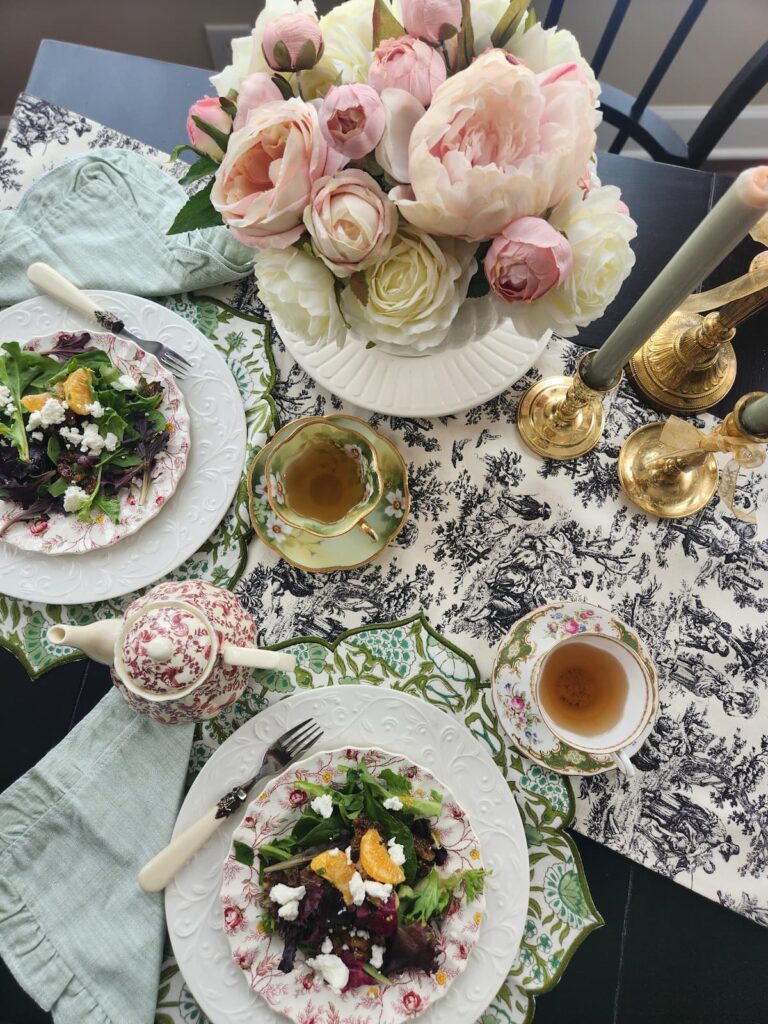

Wow looks delicious!